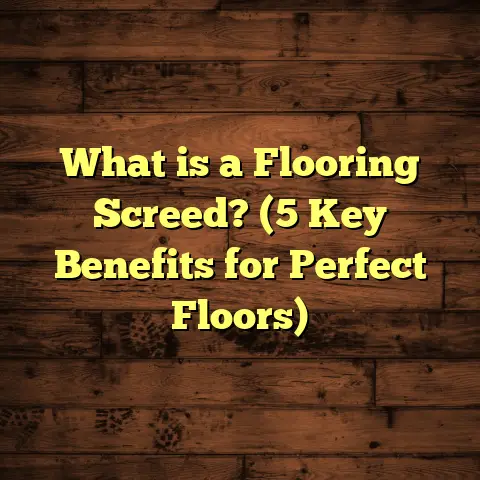What is Composite Floor Construction? (5 Key Benefits Explained)
Imagine standing at the edge of a serene lake, where the surface reflects the sky above like a perfect mirror. Just as the calm waters can shift with a breeze, flooring can transform the entire feel of a home. It’s not just about what you walk on; it’s about how that choice shapes your space, your comfort, and even your lifestyle.
When I first started working with composite floor construction, I felt like I was discovering a hidden gem in the world of flooring. Composite flooring offers a unique blend of materials that can accommodate various needs, from durability to aesthetic appeal. Let me take you on a journey into this fascinating flooring option and share some insights on its key benefits.
What is Composite Floor Construction?
Composite floor construction involves engineered materials that typically combine wood fibers and synthetic materials. This mixture creates a product that mimics natural wood while providing enhanced durability and resistance to various environmental factors. I remember my first project using composite flooring. The clients wanted something that looked elegant but could withstand the wear and tear of their busy household. I suggested composite flooring, and they were thrilled with the outcome!
The Composition of Composite Flooring
To truly appreciate composite flooring, it’s essential to understand its composition. Composite flooring is often made from a combination of:
- Wood Fibers: These are usually sourced from recycled wood products or wood chips, which reduce waste and promote sustainability.
- Plastic Resins: These synthetic materials bind the wood fibers together and provide moisture resistance.
- Additives: Various additives are included to enhance properties such as UV resistance, fire retardance, and anti-microbial qualities.
This unique combination allows composite flooring to outperform traditional hardwood in several aspects.
1. Durability
One of the standout features of composite flooring is its durability. Unlike traditional hardwood floors that can scratch and dent easily, composite flooring is engineered to resist these common issues. In fact, many composite products come with warranties ranging from 10 to 30 years, which speaks volumes about their longevity.
I recall a project where I installed composite flooring in a family home with pets. The owners were initially skeptical, fearing scratches from their lively dogs. However, after several years, they shared how well the flooring held up despite the daily chaos. It’s impressive to see how composite materials can withstand scratches, moisture, and even temperature fluctuations better than standard wood.
Real-Life Example: A Family’s Experience
I had a client named Sarah who had two energetic golden retrievers. When she first approached me for her flooring project, she expressed concern over how traditional hardwood would fare with her pets. I introduced her to composite flooring, highlighting its scratch resistance and durability against water spills.
After installation, Sarah called me three months later, ecstatic about how well the floors were holding up. The occasional paw prints were easy to clean, and she noted no visible scratches despite her dogs’ playful antics. Stories like Sarah’s affirm my belief in the performance of composite flooring.
2. Cost-Effectiveness
When I first explain composite flooring to clients, I often mention its cost-effectiveness. While solid hardwood can cost anywhere from $8 to $15 per square foot for both material and installation, composite options typically range from $3 to $7 per square foot. This price difference can significantly impact overall project budgets.
I remember working on a renovation for a couple who wanted to revamp their entire living space without breaking the bank. By choosing composite flooring, they saved enough to invest in quality furniture and decor. Plus, with platforms like FloorTally, I managed to provide precise cost estimates, helping them visualize their budget effectively.
Budgeting Insights
When planning a flooring project, it’s crucial to account for all expenses. Here’s how using tools like FloorTally can help streamline the budgeting process:
- Material Costs: FloorTally allows me to input local pricing for different types of composite flooring.
- Labor Costs: The tool provides estimates based on the complexity of installation.
- Waste Factor: It automatically includes a waste factor for unexpected cuts or miscalculations.
For instance, during one project for a small café renovation, I used FloorTally to generate an accurate estimate for the owners. They were pleasantly surprised at how much they could save by opting for composite instead of hardwood.
3. Aesthetic Variety
When it comes to aesthetics, composite flooring doesn’t fall short. With advancements in technology, manufacturers can now create composite planks that closely resemble various wood species and finishes. Whether your style leans towards rustic oak or sleek walnut, there’s likely a composite option that fits your vision.
One of my favorite installations was in a modern loft where we used dark-stained composite planks to complement industrial-style decor. The clients loved how the flooring tied everything together without the upkeep that comes with natural wood.
Exploring Design Options
Composite flooring comes in various styles, colors, and textures. Here are some popular options:
- Wood-Look Finishes: Mimicking traditional hardwood, these options create warmth and elegance.
- Textured Surfaces: Some products offer textures that enhance slip resistance while providing a natural feel.
- Color Varieties: From light ash to deep mahogany, homeowners can choose shades that suit their decor.
During one project for a beach house, we opted for light-colored composite planks that complemented the coastal vibe perfectly. The homeowners were thrilled with how their space transformed into a bright and airy retreat.
4. Eco-Friendly Options
In today’s environmentally conscious world, many homeowners seek sustainable choices. Composite flooring often includes recycled materials and uses fewer natural resources compared to traditional hardwood floors. Some brands even focus on producing eco-friendly options that are free from harmful chemicals.
I’ve had more clients express their desire for sustainable flooring solutions in recent years. During one project, I installed composite flooring made from recycled wood fibers and plastic, which not only looked great but also aligned with the homeowners’ values.
Sustainability in Action
Here are some eco-friendly features you might find in modern composite flooring:
- Recycled Materials: Many products use post-consumer recycled content.
- Low VOC Emissions: Eco-friendly composites are manufactured with fewer volatile organic compounds.
- Sustainable Sourcing: Some brands prioritize using sustainably harvested materials.
One notable installation was for an environmentally-conscious couple who wanted their new home to reflect their values. We chose a brand known for its sustainable practices, which made them feel good about their choice while also enjoying beautiful new floors.
5. Ease of Installation
Composite flooring is often designed for ease of installation, with many products featuring click-lock systems that make DIY installation possible for many homeowners. This can save both time and money on labor costs.
I recall a weekend project where my friend decided to tackle his new composite flooring installation alone. With just a few tools and some guidance from yours truly, he transformed his dining room in a matter of hours! The satisfaction he felt upon completion was priceless.
Installation Techniques
Here are some common installation techniques for composite flooring:
- Floating Installation: This method allows the planks to “float” over an underlayment without being glued or nailed down.
- Glue Down: Some products can be glued directly to the subfloor for added stability.
- Nail Down: Although less common for composites, some installers prefer this method for specific applications.
During a recent project in a high-rise apartment, we utilized the floating method due to the concrete subfloor. It not only saved time but also provided excellent sound insulation between floors.
Maintenance and Care
One of the most appealing aspects of composite flooring is its low maintenance requirements compared to traditional hardwood options. Here’s how I recommend my clients care for their new floors:
- Regular Sweeping or Vacuuming: Keeping dirt and debris off the surface helps prevent scratches.
- Damp Mopping: Use a damp mop with mild soap to clean up spills without damaging the finish.
- Avoid Harsh Chemicals: Strong cleaners can wear down the protective coating over time.
I remember visiting a client’s home several months after installing their composite floors. They were surprised at how easy it was to maintain them compared to their previous hardwood floors. They used a simple mix of water and vinegar for cleaning and shared how quickly they could clean up after their kids!
Troubleshooting Common Issues
Even with durable materials like composite flooring, issues can arise from time to time. Here are some common concerns I’ve encountered as well as tips for addressing them:
1. Scratches and Scuffs
While composite floors are resilient against scratches, they’re not completely immune. If you notice minor scratches:
- Use a Repair Kit: Many manufacturers offer repair kits specifically designed for their products.
- Buffing: A gentle buffing with a soft cloth may reduce the appearance of scuffs.
2. Water Damage
Though many composites are water-resistant, prolonged exposure can cause damage:
- Immediate Cleanup: Wipe up spills promptly using a damp cloth.
- Avoid Standing Water: Make sure no water pools on the floor for extended periods.
3. Fading or Discoloration
Direct sunlight can cause fading over time:
- Use Area Rugs: Place rugs in high-traffic areas or under furniture to protect against excessive sunlight.
- Window Treatments: Consider using blinds or curtains to limit direct sun exposure during peak hours.
I once had a client who noticed some fading on their floors near large windows after several years. We added sheer curtains that not only softened the light but also protected their beautiful floors from UV damage.
Cost Estimation Made Easy
When it comes time to budget for your flooring project, having reliable estimates is crucial. That’s where tools like FloorTally come into play! This platform helps me generate accurate cost estimates based on local material prices and labor rates.
How FloorTally Helps
Using FloorTally streamlines my process significantly:
- Local Pricing Integration: It adjusts cost estimates based on current market rates in my area.
- Detailed Breakdown: I can provide clients with itemized lists of costs related to materials and installation.
- Visual Aids: Clients appreciate visual representations of total costs versus their budget constraints.
For instance, during one project for a small boutique shop renovation, FloorTally helped us stay within budget while achieving high-quality results with composite flooring—ensuring we didn’t overlook any necessary expenses.
Personal Anecdotes and Insights
Throughout my years as a contractor specializing in flooring solutions, I’ve encountered countless stories that highlight the transformative power of composite flooring:
- The Busy Family: I worked with a family who wanted elegant yet practical options for their home with three children and two dogs. Composite flooring became their go-to solution because it provided aesthetic appeal without sacrificing durability.
- The Eco-Friendly Renovation: A couple committed to sustainability chose composite floors made from recycled materials for their new home. They expressed pride in making environmentally conscious choices while still enjoying beautiful interiors.
These real-life experiences reinforce my belief in the advantages of composite floor construction and its ability to meet diverse needs.
Emerging Trends in Composite Flooring
As technology continues to evolve, so does the world of composite flooring. Here are some emerging trends I’ve noticed over recent years:
1. Enhanced Textures and Finishes
Manufacturers are continuously developing new textures that mimic natural surfaces even more closely—think hand-scraped or wire-brushed looks that add depth and character.
2. Smart Flooring Solutions
With smart home technology on the rise, there are now options available that offer integrated features such as temperature regulation or moisture detection systems embedded within the flooring itself!
3. Customizable Designs
Many brands are now allowing homeowners to customize their composite flooring designs further—from unique patterns to personalized colors—providing an unprecedented level of creative freedom.
These trends excite me as they indicate that composite flooring is not just keeping pace with design demands but also pushing boundaries!
Final Thoughts
In my experience as a flooring contractor, composite floor construction has proven itself as a robust option for various needs and preferences. Its durability, cost-effectiveness, aesthetic variety, eco-friendliness, and ease of installation make it appealing for many homeowners.
So next time you’re considering flooring options for your home or project, think about the potential of composite materials. The right choice can make all the difference—not just in how your space looks but in how it functions day-to-day.
If you have any questions or would like to share your own experiences with composite flooring, feel free to reach out! I’m always here to chat about flooring options or help you tackle your next project.





